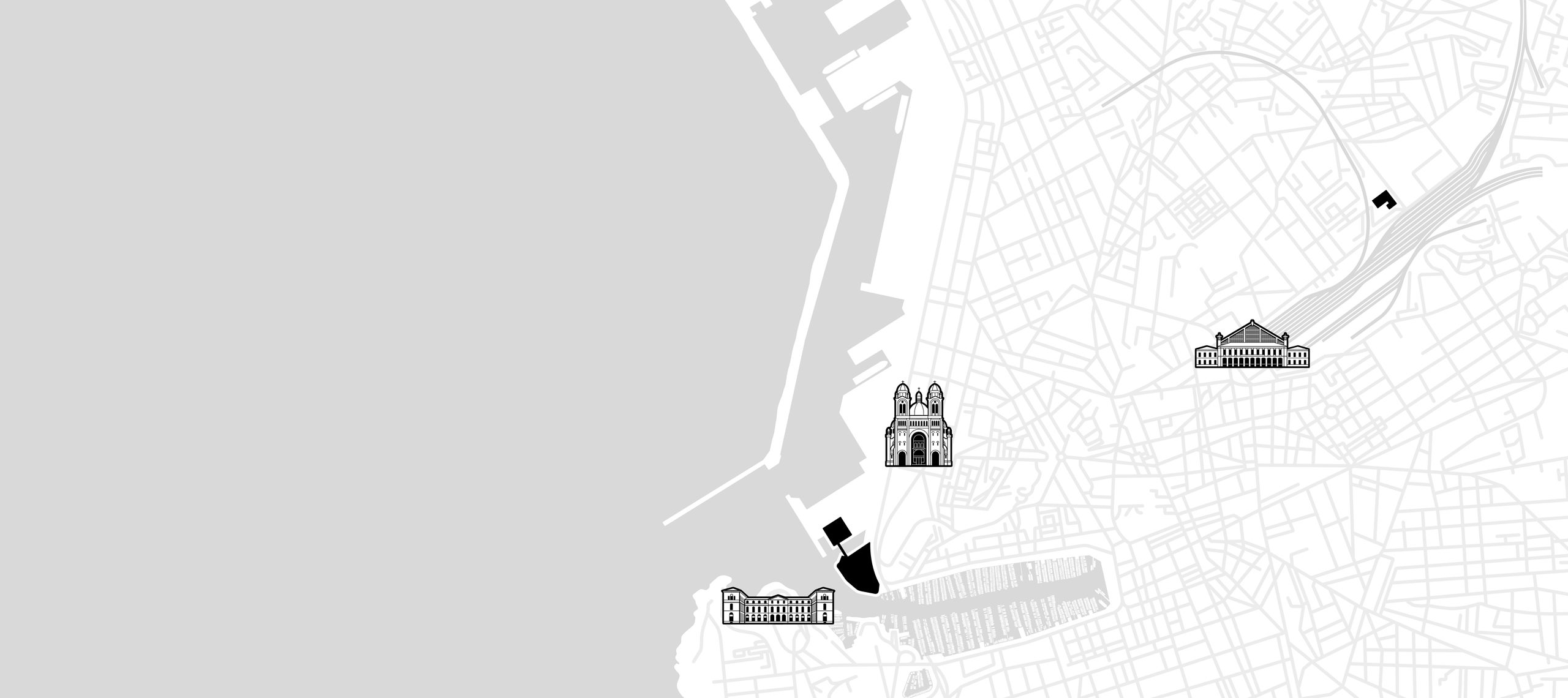Le Mucem se déploie et se visite sur trois sites uniques


J4
Fermé aujourd’huiTous les jours sauf le mardi, le 1 mai, le 25 décembre10h—18h
Fort Saint-Jean
Fermé aujourd’huiTous les jours sauf le mardi10h—18h
Centre de Conservation et de Ressources
Ouvert aujourd’hui de 09h à 17hTous les jours sauf le samedi, le dimanche09h—17h
Tarifs
Un seul billet, valable le jour même, pour d’accéder à l’ensemble des expositions permanentes et temporaires dans les espaces du J4 et du Fort Saint-Jean. Entrée libre dans les espaces extérieurs (J4 et fort Saint-Jean)
Tarif plein — 11 €
Tarif réduit — 7.50 €
Billet famille — 18 €
(valable pour 5 enfants de moins de 18 ans maximum accompagnés de 2 adultes) Les adultes non accompagnés d'enfants mineurs ne pourront pas accéder aux salles avec un billet famille.
Gratuité
Pour les expositions permanentes et temporaires. Le premier dimanche de chaque mois.
Sur présentation d’un justificatif en cours de validité pour les :
- Bénéficiaires de minima sociaux et les titulaires du minimum vieillesse,
- Demandeurs d’emploi (justificatif de moins de 6 mois),
- Moins de 18 ans (NB. Les enfants de moins de 13 ans doivent être accompagnés d’un adulte responsable),
- Grands mutilés de guerre, grands handicapés civils et anciens combattants, visiteurs handicapés et un accompagnateur (justificatif d’invalidité),
- Conférenciers et guides interprètes nationaux, régionaux,
- Journalistes titulaires de la carte de presse,
- Membres de l’Icom, de l’Icomos et de l’Aica,
- Titulaires de la carte Culture du Ministère de la Culture et de la communication et un accompagnant,
- Artistes des arts visuels,
- Amis du Mucem,
- City Pass : L’entrée au Mucem est comprise dans le City Pass de la ville de Marseille et dans le City Pass Marseille Provence.
- Etudiants d’Aix-Marseille Université (AMU), des Beaux-Arts de Marseille et Conservatoire de Marseille Pierre Barbizet – établissements de l’institut national supérieur d’enseignement artistique Marseille Méditerranée (INSEAMM), de l’École d’Architecture de Marseille (ENSA·M) et de Sciences Po Aix. La gratuité est accordée sous présentation de la carte d’étudiant en cours de validité ou à défaut d’un justificatif (attestation d’inscription, etc).
Pour les expositions permanentes seules, sur présentation d’un justificatif en cours de validité :
- Jeunes âgés de 18 à 25 ans inclus,
- Enseignants titulaires du Pass Education.
Réductions
Bénéficiez du tarif réduit pour les expositions permanentes et temporaires sur présentation d’un justificatif en cours de validité :
- Jeunes âgés de 18 à 25 ans inclus,
- Enseignants titulaires d’un Pass Education en cours de validité (attention, le « e-Pass Education » n’est pas accepté comme indiqué par le Ministère de l’Education nationale : Pass éducation : gratuité des musées et monuments nationaux | Ministère de l’Education Nationale et de la Jeunesse ) et enseignants du supérieur en activité en France
- Pour les personnes munies d’un billet plein tarif musée Regards de Provence, FRAC du jour ou musée Granet (Aix-en-Provence) de moins de 6 mois
- Personnels de l’Assistance Publique – Hôpitaux de Marseille
- Carte VYV avantages : Tarif réduit pour les expositions sur présentation de la carte
Bénéficiez du tarif réduit sur la programmation artistique et les visites guidées :
- Visiteurs munis d’un billet Mucem du jour de la manifestation
- Bénéficiaires de minima sociaux dont les titulaires du minimum vieillesse,
- Demandeurs d’emploi (justificatif de moins de 6 mois),
- Moins de 18 ans (*NB. Les enfants de moins de 13 ans doivent être accompagnés d’un adulte responsable).
- Jeunes âgés de 18 à 25 ans inclus,
- Grands mutilés de guerre, grands handicapés civils et anciens combattants, visiteurs handicapés et un accompagnateur (justificatif d’invalidité),
- Carte VYV avantages : Tarif réduit sur une sélection d’événements à l’Auditorium
- Amis du Mucem
- Etudiants d’Aix-Marseille Université (AMU), des Beaux-Arts de Marseille et Conservatoire de Marseille Pierre Barbizet – établissements de l’institut national supérieur d’enseignement artistique Marseille Méditerranée (INSEAMM), de l’École d’Architecture de Marseille (ENSA·M) et de Sciences Po Aix. La gratuité est accordée sous présentation de la carte d’étudiant en cours de validité ou à défaut d’un justificatif (attestation d’inscription, etc).
Munissez-vous de vos écouteurs pour profiter de nos podcasts de visite !

Suivez les parcours audios de 30 minutes grâce à nos podcasts de visite en libre écoute.
Pour y accéder c’est facile, connectez vous avec votre téléphone sur visit.mucem.org ou flashez le QR code situé à l’entrée du musée et des expositions avec votre connexion internet ou le réseau WiFi gratuit.
Vous accéderez alors à l’application gratuitement, sans téléchargement. Les commentaires sont disponibles en 2 langues : français, anglais. Pensez à vous munir de vos écouteurs.
Branchez vos écouteurs et laissez vous guider !
Webapp développée par Mazédia et contenus audios produits par Audiovisit.
Parcours disponible en LSF et en audio-description.
Groupes adultes
- Visite guidée 1h : 290€ (billet Mucem inclus)
Visite guidée 1h30 : 320€ (billet Mucem inclus)
Visite autonome : droit de réservation 35€ (billet Mucem non inclus)
Réservation obligatoire au plus tard quinze jours à l’avance pour les visites guidées et une semaine pour les visites autonomes.
Tous les jours de 9h à 18h :
- Tel : 04 84 35 13 13
- Mail : reservation@mucem.org
- Visite guidée 1h : 290€ (billet Mucem inclus)
CE, collectivités, associations
Le Mucem vous fait bénéficier toute l’année d’offres permettant à vos salariés ou membres de profiter de nombreux avantages. Billets valables pendant un an à partir de la date d’achat, coupe-file aux entrées extérieures des bâtiments et aux caisses.
Inscrivez-vous à la Newsletter Pro pour recevoir des informations privilégiés, des rendez-vous spécifiques, des invitations tout au long de l’année.
Commande par téléphone, courrier électronique ou sur le site internet (sous conditions) : ce@mucem.org
Billets disponibles sous 48h après règlement, en retrait sur place ou par envoi postal.- À partir de 30 billets : 5% de remise
- À partir de 100 billets : 10% de remise
- À partir de 250 billets : 15% de remise
- À partir de 500 billets : 20% de remise










